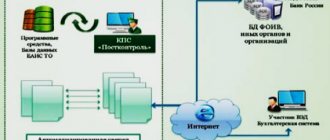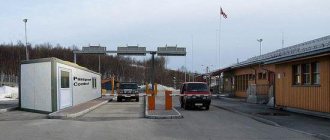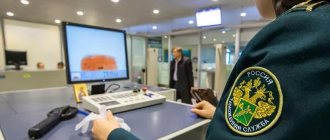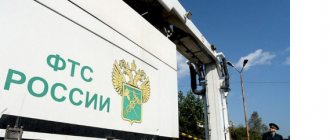Home — Articles
Federal Law of December 26, 2008 N 294-FZ “On the protection of the rights of legal entities and individual entrepreneurs in the exercise of state control (supervision) and municipal control” (as amended by the Federal Law of July 18, 2011 N 242-FZ) ( hereinafter referred to as Law N 294-FZ) vests federal executive authorities exercising state control (supervision) with the authority to adopt administrative regulations for the implementation of federal state control (supervision) or conducting inspections in relevant areas of activity. At the same time, the Federal Customs Service of Russia has not adopted a single administrative regulation in this area. It seems that determining the types of administrative regulations that need to be adopted is impossible without a thorough analysis of the control and supervisory activities of customs authorities.
customs control
In accordance with Art. 6 of the Customs Code of the Customs Union (hereinafter referred to as the Customs Code of the Customs Union), the main tasks of customs authorities include the implementation of customs control (Customs Code of the Customs Union (Appendix to the Agreement on the Customs Code of the Customs Union, adopted by the Decision of the Interstate Council of the EurAsEC at the level of heads of state dated November 27, 2009. N 17)), and clause 1, part 1, art. 12 of the Federal Law of November 27, 2010 N 311-FZ “On Customs Regulation in the Russian Federation” (hereinafter referred to as the Law on Customs Regulation in the Russian Federation) designates the conduct of customs control and the improvement of methods for its implementation as the main functions of customs authorities.
Customs control is the most important comprehensive institution of customs affairs. In the broadest sense, customs control is a type of state control carried out exclusively by customs authorities (Article 95 of the Labor Code of the Customs Union). The obligatory nature of its implementation follows from the enshrined Art. 150 of the Customs Code of the Customs Union rules according to which all goods transported across the customs border of the Customs Union are subject to customs control in the manner established by the customs legislation of the customs legislation and the legislation of the member states of the Customs Union. The general definition of state control (supervision), as well as the procedure for its organization and implementation, is enshrined in Law No. 294-FZ. Analysis of Art. 1 of this Law, which establishes the scope of application of the Law, indicates its extension to customs control. At the same time, Law No. 294-FZ does not fully cover customs control. Clause 4 art. 1 of this Law includes customs control in the list of types of state control, the specifics of the organization and implementation of which, in terms of the type, subject, grounds of inspections, timing and frequency of their conduct, notification of an unscheduled on-site inspection, may be established by other federal laws. This is quite justified, since customs control has significant features that distinguish it from other types of state control covered by the regulation of Law N 294-FZ. Determining administrative procedures for customs control, which must be regulated by administrative regulations, is impossible without considering these features. Firstly, this is a subject of control . The subject of inspection of state control (supervision) within the framework of Law N 294-FZ is the activities (actions, inactions) of legal entities and individual entrepreneurs. The subject of customs control is more diverse. According to paragraph 2 of Art. 95 of the Customs Code of the Customs Union, customs control is carried out by customs officials in relation to: goods, including vehicles, moved across the customs border and (or) subject to declaration in accordance with the Customs Code of the Customs Union; customs declaration, documents and information about goods, the presentation of which is provided in accordance with the customs legislation of the Customs Union; activities of persons related to the movement of goods across the customs border, the provision of services in the field of customs affairs, as well as carried out within the framework of certain customs procedures; persons crossing the customs border. Secondly, the set of control methods used . Law N 294-FZ establishes only one method of control - inspections. The customs authorities have twelve forms of customs control in their arsenal (Article 110 of the Customs Code of the Customs Union). Thirdly, the frequency of control activities . So, according to paragraph 2 of Art. 9 of Law N 294-FZ, scheduled inspections are carried out no more than once every three years. The Customs Code of the Russian Federation does not establish this period, which is quite natural. Based on the time of customs control, there are preliminary control (in the case of preliminary declaration), current control (carried out in relation to imported and exported goods and vehicles), and subsequent control (carried out after the release of goods). At the same time, restrictions on the frequency of control activities are established in relation to subsequent control only. According to Art. 99 of the Customs Code of the Customs Union, customs authorities carry out customs control after the release of goods within three years from the date the goods are under customs control. Fourthly, the content of customs control . Customs control has a rather complex structure, determined by the essence and procedure for its implementation. In a narrow sense, customs control is defined by scientists as a set of verification actions in certain forms that are sufficient to ensure compliance with and detect significant violations of the customs legislation of the Russian Federation. However, this approach limits the understanding of the content of customs control. According to Art. 4 of the Customs Code of the Customs Union, customs control is a set of measures carried out by customs authorities, including using a risk management system, in order to ensure compliance with the customs legislation of the Customs Union and the legislation of the member states of the Customs Union. Article 110 ch. 16 of the Customs Code of the Customs Union establishes 12 forms of customs control, which form a procedural form of implementation of control measures: verification of documents and information; oral survey; receiving explanations; customs surveillance; customs inspection; customs inspection; personal customs inspection; checking the marking of goods with special marks and the presence of identification marks on them; customs inspection of premises and territories; accounting of goods under customs control; checking the goods accounting and reporting system; customs check. Each form of customs control can be considered as an independent administrative procedure, characterized by specific tasks, a special subject, procedure and methods of implementation, and a set of rights and obligations of customs authorities and inspected persons. At the same time, these forms of control are heterogeneous in their legal essence. Such forms of customs control as verification of documents and information, customs inspection, customs inspection, personal customs inspection, checking the marking of goods with special marks, the presence of identification marks on them, customs inspection of premises and territories, checking the system of accounting for goods and reporting, customs inspection, are the nature of verification activities, within the framework of which the compliance of customs control objects with the requirements of customs legislation is assessed. It seems that this particular group of forms of customs control should be covered by the subject of regulation of administrative regulations. Other forms of customs control have a different character from inspection activities. Thus, the basis for obtaining explanations and oral questioning is to clarify any information or obtain additional information necessary to carry out customs control. Customs surveillance is the actions of customs officials, consisting of visual monitoring of the transportation of goods, including vehicles under customs control, and the performance of cargo and other operations with them. Accounting for goods under customs control is a responsibility assigned to the customs authorities. A specific form of customs control predetermines a different volume of administrative actions performed in the process of its implementation, and, as a consequence, different details of its legal regulation. The larger and more complex the form, the more legal norms governing it. Thus, the simplest forms of customs control - oral questioning (Article 112 of the Customs Code), receiving explanations (Article 113), customs supervision (Article 114 of the Customs Code) - are allocated only one article in the Customs Code, revealing their essence. The procedural issues of their implementation are not detailed, which is quite natural. The implementation of other forms of customs control in customs legislation is given greater attention. For example, customs inspection of premises and territories is regulated in Art. 119 TC TC, Art. 175 of the Law on Customs Regulation in the Russian Federation, verification of the accounting and reporting system - Art. 121 TC TC, Art. 177 of the Law on Customs Regulation in the Russian Federation, is described in detail in Art. 117 TC CU procedure for conducting personal customs inspection. One of the most extensive administrative procedures of customs control is customs inspection. Chapter is devoted to this form of customs control. 19 TC TC, Art. Art. 178 - 185 of the Law on Customs Regulation in the Russian Federation. The need to adopt legal acts establishing the procedure for applying certain forms of customs control is indicated in a number of cases by the Customs Code itself, for example, on the accounting of goods under customs control (Article 120 of the Customs Code), checking the system of goods accounting and reporting (Article 121 of the Customs Code TS). However, most legal acts are adopted by the Federal Customs Service of Russia on an initiative basis, which indicates the practical need to unify procedural issues in the implementation of control measures by customs authorities (Order of the Federal Customs Service of Russia dated April 29, 2011 N 895). At the same time, such forms of customs control as customs inspection (Article 115 of the Customs Code of the Customs Union), checking the labeling of goods with special marks and the presence of identification marks on them (Article 118 of the Customs Code of the Customs Union) remained outside the scope of the departmental rule-making of the Federal Customs Service of Russia.
Along with the forms of customs control, it is also necessary to highlight the types of control carried out as part of its implementation. Thus, a detailed classification of types of customs control has been proposed: 1) by subjects subject to customs control; 2) by the nature of implementation; 3) on the subject of customs control; 4) according to the form of implementation; 5) in the direction of movement of goods; 6) by the method of movement of goods; 7) according to the customs procedures used. These classifications make it possible to see the variety of control measures carried out by customs authorities. At the same time, some types of customs control indicated in this classification have theoretical significance, others have practical significance, representing administrative procedures that stand out in the general procedure for carrying out customs control. Among these types of customs control, it is necessary to highlight types of control characterized by a special subject of control. These include: control of the correct classification of goods (Article 52 of the Labor Code of the Customs Union); control over determining the country of origin of goods (Article 110 of the Law on Customs Regulation in the Russian Federation); control of the customs value of goods (Article 66 of the Customs Code of the Customs Union). They are distinguished by the fact that these types of customs control are distinguished directly by customs legislation, are mandatory stages of customs control, and represent a set of verification activities. Based on the results of their implementation, strictly formalized decisions are made (on the classification of goods; the country of origin of goods and (or) the provision of tariff preferences; acceptance of the declared customs value of goods; adjustment of the declared customs value), entailing important legal consequences for persons declaring goods: confirmation by customs bodies declared during customs declaration of information or non-confirmation and, as a consequence, additional accrual of customs duties due for payment, application of prohibitions and restrictions to goods, refusal to provide tariff preferences, refusal to release goods, etc. The legal significance and essence of these types of control determine the need for clear regulation of the procedure for their implementation. The unified Procedure is provided only for the control of customs value (Decision of the Customs Union Commission dated September 20, 2010 N 376 “On the procedures for declaring, monitoring and adjusting the customs value of goods”). Nevertheless, the procedural issues of its implementation are also specified in the Order of the Federal Customs Service of Russia (Order of the Federal Customs Service of Russia dated February 14, 2011 N 272). The procedure for implementing the remaining above types of control is regulated in departmental regulatory legal acts of the Federal Customs Service of Russia (Order of the Federal Customs Service of Russia dated September 29, 2004 N 80).
Customs control of intellectual property objects is characterized by a special procedure. Ensuring the protection of intellectual property rights in the customs territory of the Customs Union is considered by the CU TC to be the main tasks of customs authorities (clause 9, clause 1, article 6 of the CU TC), and clause 7, part 1, art. 12 of the Law on Customs Regulation in the Russian Federation - to the main functions of customs authorities. Measures to protect rights to intellectual property objects are taken in relation to goods included at the request of the right holders in the customs register of intellectual property objects. Order of the Federal Customs Service of Russia dated August 13, 2009 N 1488 approved the Administrative Regulations for the execution of the state function of maintaining the customs register of intellectual property objects (Order of the Federal Customs Service of Russia dated August 13, 2009 N 1488 “On approval of the Administrative Regulations of the Federal Customs Service for the execution of the state function of maintaining customs register of intellectual property objects"). Thus, the state function of maintaining a customs register of intellectual property is part of another function - ensuring the protection of rights to intellectual property.
The performance of the function of protecting rights to intellectual property is reflected in Order of the Federal Customs Service of Russia dated March 25, 2011 N 626 “On approval of the Procedure for actions of the customs authorities of the Russian Federation when taking measures to protect rights to intellectual property” (The document was not published). This Procedure determines the list, timing and sequence of actions of the customs authorities of the Russian Federation when taking measures to protect rights to intellectual property related to the suspension of the release of goods, as well as the procedure for interaction in the performance of functions related to ensuring the protection of rights to intellectual property.
It seems that in its essence this Procedure performs the functions of an Administrative Regulation. It lists the administrative procedures associated with the implementation of this function: maintaining a customs register; suspension of the release of goods; carrying out inspection activities; exchange of information between customs authorities, etc. However, the Procedure regulates only part of them. Thus, administrative procedures related to the implementation of the function of protecting rights to intellectual property are not limited to maintaining the customs register, for which administrative regulations have been adopted. In order to streamline the execution of the above function, appropriate regulations must be adopted that would regulate the entire complex of administrative procedures, the implementation of which contributes to the implementation of this function. In addition, the Federal Customs Service of Russia has adopted regulatory legal acts that establish the specifics of customs control depending on the method of movement of goods, the nature of the customs procedures used and other circumstances that determine the use of special types of administrative control procedures, a special procedure for their application (Order of the Federal Customs Service of Russia dated May 26, 2011 city N 1067).
Summarizing the above, it is necessary to draw the following conclusions. Customs control is a collective concept that includes a set of control measures that differ primarily in the type of inspection and the form of implementation. Taking into account the purpose of administrative regulations as a legal form of state control (supervision), control activities carried out within the framework of customs control, which are independent administrative proceedings, must be regulated by administrative regulations. The situation when administrative regulations are replaced by the adoption by the Federal Customs Service of Russia of various legal acts (instructions, orders, etc.), as well as documents of a non-normative nature (letters, methodological recommendations) regulating administrative procedures for the implementation of control and supervisory functions, is not acceptable. In this regard, the Federal Customs Service of Russia needs to carry out work in the following two important areas: to develop administrative regulations for the forms and types of customs control, the timing and sequence of administrative procedures (actions) during the implementation of which remain unregulated and, therefore, unified; to systematize the documents adopted by the Federal Customs Service of Russia on the regulation of procedural issues in the implementation of administrative procedures of customs control, rework them and replace them with administrative regulations.
How is the inspection carried out?
Notice of inspection
After the risk management system is automatically triggered, the customs authorities notify the declarant or cargo owner about the appointment of a customs inspection. Possible purpose of customs inspection:
- identification of goods;
- custom scan.
Possible scope of customs inspection:
- 10%
- 50%
- 100%
Possible degree of customs inspection:
- weighing (full/selective)
- recalculation of cargo packages (selective opening/opening of all packages)
- recalculation of the number of items in cargo packages (selectively/all)
- measurement and determination of the characteristics of goods (with partial disassembly / with complete disassembly) without taking samples and specimens
- with sampling and sampling
Search procedure
The declarant or cargo owner is required to be present during the inspection together with the inspection inspector. Customs authorities do not have the right to inspect cargo without the cargo owner or his representative.
Activities when ordering a full inspection:
- Opening of all packages, including original packaging;
- Photographing all articles, markings;
- Weighing of all goods.
Drawing up an inspection report
After passing the customs inspection, a report is drawn up, which indicates the results of the inspection with the attachment of all necessary photographs.
In case of violation of customs legislation, a violation report is drawn up, followed by customs sanctions against the importer and/or his cargo.







